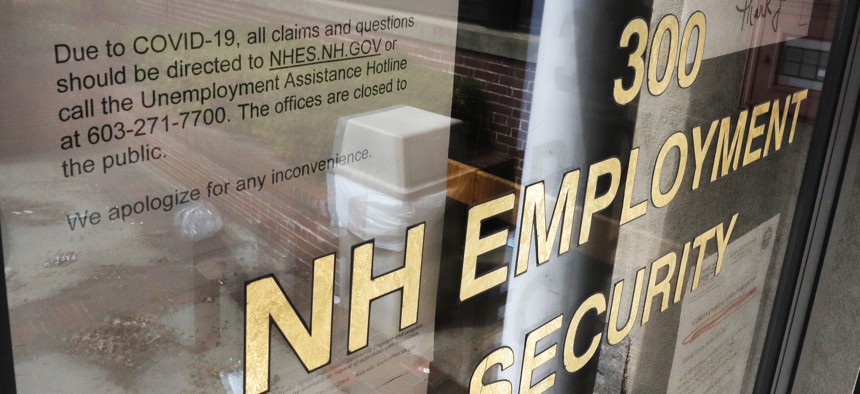Filing for Unemployment Doesn’t Have to Be So Terrible

A note on a locked door at the New Hampshire Employee Security center, which handles unemployment claims, gives directions to those in need in Manchester, N.H., Thursday, April 16, 2020. AP Photo/Charles Krupa
State unemployment systems were overwhelmed by filings during the pandemic. A new report lays out basic steps states can take to make the claims process easier for users.
States’ unemployment insurance systems were put to the test this year as millions of people filed for benefits after the coronavirus pandemic forced them out of work.
Some state unemployment offices were able to handle the onslaught of claims better than others. But many out-of-work Americans encountered overwhelmed systems, clogged phone lines or downed websites that severely delayed their ability to begin receiving benefits.
An immediate overhaul of a state’s unemployment system may be impractical as governments are still reeling from the continued economic crisis brought on by the pandemic, but a new report recommends basic improvements that can be made in a short amount of time that could drastically improve the user experience.
The report, by the National Employment Law Project, the Century Foundation, and Philadelphia Legal Assistance, analyzed the unemployment offices of states that had recently modernized their computer systems. Even among those states, some simple best practices were not being followed.
Some state unemployment systems did not accept filings 24 hours a day, 7 days a week, or required users to call into the state office to request a password reset rather than allowing them to ask for a reset online, said Michele Evermore, a senior policy analyst at NELP.
“That is something a state could do overnight or in short order,” she said.
Twenty states have modernized their unemployment insurance systems since 2001, meaning they transitioned from a legacy mainframe system to modern technology that supports web-based services, according to the report. States that modernized generally had an easier time setting up the sort of new payment programs that were required to payout benefits during the pandemic, Evermore said. This was key as the federal government has created new categories of benefits, such as paying benefits for contract workers or the enhanced federal benefits people received from the CARES Act.
But those improvements didn’t guarantee that the user experience was any easier.
“When states modernized, they improved the practice behind the wall,” Evermore said. “It’s more about internal processes than it is about access or usability.”
The report recommends six ways that states can take action now to improve the accessibility of their systems:
- Make unemployment systems available 24/7 online.
- Ensure unemployment services websites and applications are mobile-friendly as many low-wage workers rely on their phones for internet access.
- Implement secure password reset protocols that do not require action by the agency.
- Use callback systems or chatbots to help deal with the unprecedented volume of calls to unemployment agencies.
- Create a triage business model that allows junior staff to handle the basic questions and frees up experienced staff to handle more challenging questions.
- Translate website materials into Spanish and other commonly spoken languages so that residents with limited English do not have to rely on speaking to an interpreter over the phone for basic services.
Evermore is hopeful the failures that unemployment systems experienced during the height of the pandemic will push states to overhaul and improve their systems in the future. In addition to modernizing and making systems more user accessible, she said states should also consider auditing their systems to determine where the choke points are that slow down benefit approval and whether checks in place to detect fraud are working or just slowing the system down.
Andrea Noble is a staff correspondent with Route Fifty.
NEXT STORY: First Came Legal Marijuana, Now Comes…Magic Mushrooms?





